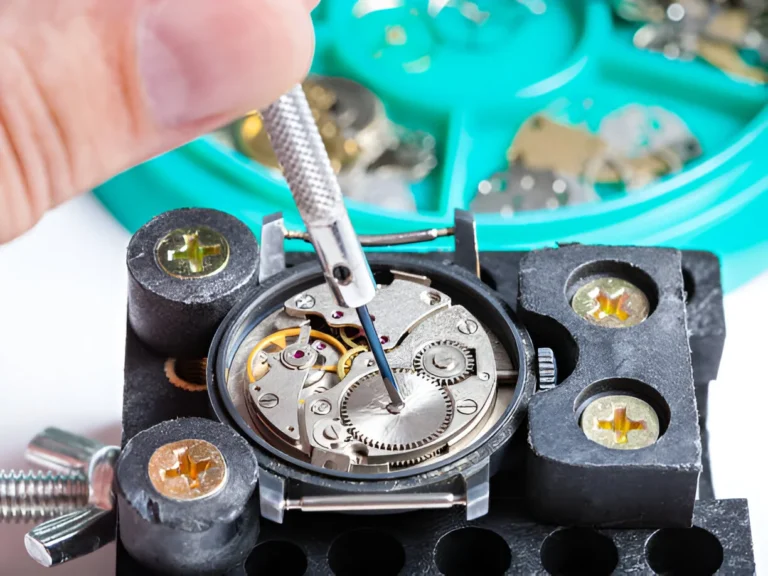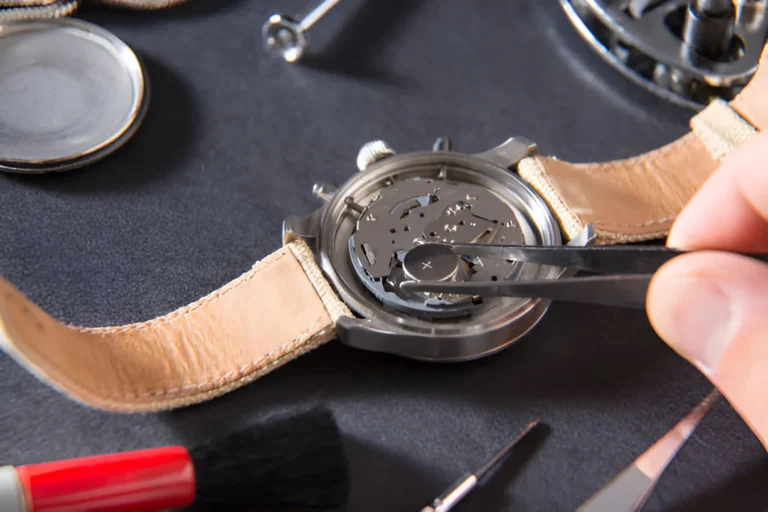
A detailed guide to understanding watch battery sizes and their equivalents
Last Updated on October 1, 2025 by admin
Table of Contents
Finding the right watch battery can be hard for many. Your watch’s performance depends on the right battery size and type. Whether it’s a classic Timex or a Swiss watch, knowing about battery sizes is key.
Watch batteries power millions of watches worldwide. From simple digital watches to complex chronographs, each needs a specific battery. The wrong battery can harm your watch.
Key Takeaways
- Watch battery sizes vary across different watch brands and models
- Proper battery selection prevents potential damage to your watch
- Battery chemistry impacts performance and longevity
- Understanding battery standards helps in finding the right replacement
- Regular battery maintenance extends your watch’s operational life
This guide will help you understand watch batteries sizes. You’ll learn how to choose the right battery for your watch. You’ll also know about international sizing standards. This knowledge will help keep your watch running well.
The Basics of Watch Battery Types and Their Importance
Choosing the right watch battery is key to keeping your watch in top shape. These batteries power the complex parts that make your watch tick right. They ensure your watch keeps perfect time.
Primary vs. Secondary Watch Batteries
Watch batteries fall into two main groups:
- Primary Batteries: These are for one-time use only.
- Secondary Batteries: You can recharge these batteries multiple times.
Common Watch Battery Chemistry Types
There are various watch battery sizes and types for different needs:
| Battery Type | Voltage | Common Uses |
|---|---|---|
| Silver Oxide | 1.55V | Precision watches, chronographs |
| Lithium | 3V | Digital and sports watches |
| Alkaline | 1.5V | Basic analog watches |
Understanding Battery Voltage Requirements
Your watch needs a specific voltage to work right. The wrong battery can harm your watch or make it run poorly.
“Always match the exact voltage and chemistry specified by your watch manufacturer to ensure optimal performance.”
Choosing the right watch battery is all about knowing these important details. This helps your watch run smoothly and accurately.
How to Identify Your Watch Battery Size
Finding the right watch battery size can seem tough. But, with the right steps, you’ll get it in no time. Your watch battery size chart is your go-to for the perfect battery for your watch.
First, check the back of your watch case. Most watches have important battery info right there. Look for:
- Battery size code
- Voltage specification
- Manufacturer’s recommended battery type
If the case back doesn’t have clear info, check your watch’s user manual. Manufacturers usually list exact battery specs in these guides. Digital and smartwatches might need special batteries, unlike traditional watches.
“Precision is key when selecting a watch battery replacement” – Watch Repair Professionals
Your watch battery size chart is crucial. It helps match not just size, but also voltage and chemistry. Each watch needs specific batteries to work best.
Here are some tips for finding your watch battery size:
- Measure the battery diameter and height
- Check the existing battery’s code
- Use a watch battery size chart for cross-referencing
- Verify voltage compatibility
If you’re unsure, visit a professional watch repair shop. They can quickly find the right battery size for you. This way, you avoid damaging your watch.
Watch Batteries Sizes and Standard Numbering Systems
Finding the right watch battery size can be tricky because of different standards worldwide. Watch makers and battery companies use special codes to help you pick the right battery. These codes make sure you get the exact battery your watch needs.
Every country and group has its own way of naming battery sizes. Knowing these helps you use battery charts with ease.
Swiss Battery Size Standards
Swiss watches are famous for their exact battery sizes and codes. Brands like Swatch and Omega stick to these rules:
- They use codes that show size and height
- They focus on exact sizes for special watches
- They give full details for complex watches
Japanese Battery Size Standards
Japanese brands like Seiko and Citizen have their own rules for battery sizes:
- They aim for small sizes for simple watches
- They use metric measurements
- They standardize sizes for electronic watches
IEC Battery Size Standards
The International Electrotechnical Commission (IEC) sets global standards for battery sizes:
| Standard Code | Typical Diameter | Common Watch Types |
|---|---|---|
| SR41 | 7.9mm | Small dress watches |
| CR2032 | 20mm | Large digital watches |
| SR626SW | 6.8mm | Slim analog watches |
Always check different standards when looking for a new battery. This makes sure it fits your watch perfectly.
Most Common Watch Battery Sizes for Popular Brands
Finding the right watch battery can be hard. There are many sizes to choose from. Each brand has its own battery type, based on its design and power needs.
Let’s look at the most common watch battery sizes for well-known brands:
- Timex and Casio Watches
- CR2016 watch battery
- CR2025 watch battery
- SR626SW watch battery
- Seiko and Citizen Watches
- SR621SW watch battery
- SR920SW watch battery
- CR2032 watch battery
Your watch’s model tells you the exact battery size you need. Always check your watch’s manual or the current battery to find the right fit.
“Knowing your watch battery size is crucial for maintaining your timepiece’s accuracy and performance.”
When looking for watch batteries, remember these important points:
- Battery diameter
- Battery height
- Battery chemistry type
- Voltage requirements
Professional watch repair shops can help if you’re not sure. Many stores offer free battery identification and replacement services.
Understanding Battery Size Charts and Cross-References
Finding the right watch battery can be tough without the right tools. A battery equivalent chart is like a map to the perfect battery for your watch.
Identifying the right battery means looking at more than just size. You need to know how different brands match their batteries in their charts.
How to Read Battery Equivalent Charts
When you look at a battery chart, pay attention to these key points:
- Battery chemistry type
- Voltage rating
- Physical dimensions
- Manufacturer code
Finding the Right Replacement Using Charts
Choosing the right battery is about matching several details. Here’s how to use a button battery chart well:
- Find your current battery’s model number
- Check the voltage and size
- Make sure the chemical makeup is right
- Look at different manufacturer charts
Popular Battery Brand Conversions
Many brands make batteries that work the same way. Here’s a guide for common watch battery brands:
| Original Battery | Equivalent Replacement | Voltage |
|---|---|---|
| Maxell SR416SW | Energizer 377 | 1.55V |
| Sony SR44 | Renata 357 | 1.55V |
| Seiko SB-T15 | Vinnic L1154F | 1.5V |
Pro tip: Always check if the battery fits your watch model before you replace it.
“Precision matters when selecting watch batteries – never compromise on quality or specifications.”
How to Measure Watch Battery Dimensions
Getting the right watch battery size is key. It’s important for both old and new watches. Accurate measurements save time and avoid headaches.
To measure watch batteries sizes correctly, you’ll need a few essential tools:
- Digital caliper
- Magnifying glass
- Ruler with millimeter markings
When measuring your watch battery, focus on three key dimensions:
- Diameter: Measure the width of the battery from edge to edge
- Thickness: Check the height or depth of the battery
- Special features: Note any tabs, protrusions, or unique characteristics
Being precise is crucial when measuring watch batteries sizes. A small mistake, like 0.1mm, can lead to the wrong battery for your watch.
| Measurement Tool | Precision Level | Best For |
|---|---|---|
| Digital Caliper | 0.01mm | Most accurate measurements |
| Ruler | 1mm | Rough sizing |
| Magnifying Glass | Varies | Inspecting battery details |
Pro tip: Always remove the battery carefully and measure it on a clean, flat surface. Compare your measurements with standard watch battery size charts for the most accurate replacement.
“Accuracy in measurement is the key to finding the perfect watch battery replacement.” – Watch Repair Experts
Factors Affecting Watch Battery Life and Performance
Your watch battery’s life depends on several key factors. These factors can greatly affect how long it lasts and how well it works. Knowing these helps you get the most out of your battery and avoid sudden power loss.
Environmental Influences on Battery Durability
Watch batteries are very sensitive to their surroundings. Extreme temperatures can shorten their life a lot:
- High temperatures speed up chemical reactions, leading to faster battery use
- Cold weather can slow down how well your battery works
- High humidity can cause corrosion and problems with electrical connections
Power Consumption Patterns
The features of your watch greatly affect its battery life. Different functions use different amounts of power:
- Backlighting uses a lot of energy
- Chronograph and stopwatch functions use more power
- Digital displays use more power than analog watches
Battery Brand Quality Variations
Not all watch batteries are the same. High-quality brands offer better performance and last longer. The main differences are:
- Chemical composition affects how efficient the battery is
- How well it’s made impacts its reliability
- Better-quality batteries give more consistent voltage
“Investing in a high-quality watch battery can save you time and frustration in the long run.” – Watch Maintenance Expert
When picking a watch battery, think about how you use it and where you wear it. This ensures it works its best.
Common Mistakes When Choosing Watch Batteries
Choosing the right watch battery can be tricky. Many people make mistakes that can damage their watches or make them not work well. Knowing these common mistakes helps you make better choices when looking at a watch battery size chart.
- Ignoring Voltage Specifications: Not all batteries are the same. Picking a battery with the wrong voltage can harm your watch’s internal parts.
- Overlooking Battery Chemistry: Different watches need specific battery types. Silver oxide, alkaline, and lithium batteries work differently.
- Relying on Physical Size Alone: While size is important, a watch battery size chart shows more than just size.
Buying low-quality or fake batteries is risky. These batteries often don’t meet quality standards and can leak, corrode, or fail early. Always buy from trusted brands and authorized sellers when looking at your watch battery size chart.
“A cheap battery today could mean an expensive watch repair tomorrow.” – Watch Repair Experts
Using non-specialized batteries is a bad idea. Household batteries don’t have the special design watches need. Always use the exact battery type your watch maker suggests.
| Mistake | Potential Consequence |
|---|---|
| Mismatched Voltage | Electronic Circuit Damage |
| Wrong Battery Chemistry | Reduced Performance |
| Counterfeit Batteries | Potential Watch Failure |
By avoiding these common mistakes and carefully checking a watch battery size chart, you’ll keep your watch working well for a long time.
Professional Tips for Watch Battery Replacement
Replacing a watch battery can seem daunting. But with the right tools and knowledge, you can do it at home. Knowing the correct process protects your watch and keeps it accurate.
Essential Tools and Materials
Before starting, gather these critical tools:
- Precision screwdriver set
- Watch case opener
- Soft cloth or work surface
- Tweezers with non-conductive tips
- Replacement watch battery matching your specific watch batteries sizes
Step-by-Step Replacement Process
Follow this careful method to replace your watch battery:
- Identify the correct watch battery size for your specific model
- Work on a clean, soft surface to prevent scratching
- Carefully open the watch case using appropriate tools
- Note the existing watch battery’s orientation
- Gently remove the old battery using non-metallic tweezers
- Insert the new battery with identical orientation
- Securely close the watch case
Certain watches, especially high-end or water-resistant models, might need professional service. If unsure, consult a watch repair specialist to avoid damage.
“Precision and patience are key when replacing a watch battery.” – Watch Repair Expert
Safety Precautions
Always handle watch batteries carefully. Wear protective glasses and work in a well-lit area. Avoid touching battery contacts directly and dispose of old batteries at designated recycling centers.
Conclusion
Knowing about watch battery sizes is key to keeping your watch working well. By learning to read a watch battery size chart, you can pick the right battery for your watch. This ensures your watch runs accurately and reliably.
Choosing the right battery is more than just finding the right size. You also need to think about voltage, chemistry, and how well it performs. This careful selection is vital for your watch’s precision.
There are many battery types to choose from, like Swiss, Japanese, and IEC standards. Knowing about different chemistries helps you make better choices. A detailed watch battery size chart is your best friend in finding the perfect battery for your watch.
But battery care is more than just replacing it. Things like temperature and how you use your watch affect battery life. It’s also important to dispose of batteries properly and recycle them to protect the environment.
With the knowledge from this guide, you’re ready to handle watch batteries with confidence. Whether you have an old watch or a new smartwatch, knowing about battery sizes and how to choose them will keep your watch in top shape for years.
FAQ
How do I know which battery size my watch needs?
To find your watch battery size, check the old battery code. Look at the watch case back or the user manual. Use a watch battery size chart for comparison. If unsure, a professional can help find the right battery.
Can I use a different brand of battery in my watch?
Yes, but make sure the new battery matches your watch’s specs. Look at size, voltage, and chemistry type. Brands like Maxell, Renata, or Sony are good alternatives if they match your original battery.
How often should I replace my watch battery?
Watch batteries last 1-3 years, depending on the watch and how often you use it. Watch features and temperature also affect battery life. Replace it when your watch runs slow or stops.
What tools do I need to replace a watch battery?
You’ll need a battery replacement kit. This includes a small screwdriver, battery removal tool, magnifying glass, soft cloth, and a new battery that matches your watch’s specs.
Are watch batteries universal?
No, watch batteries vary in size, voltage, and chemistry. Each watch brand and model needs a specific battery type. Always use the exact battery recommended for your watch to avoid damage.
How can I extend my watch battery’s life?
To extend battery life, avoid extreme temperatures and remove the battery when not in use. Minimize power-intensive features and store your watch in a cool, dry place. Regular use keeps the battery active.
Can I replace the watch battery myself?
Many people can replace watch batteries, but it depends on your skill and the watch type. Simple watches are usually manageable. But, water-resistant or luxury watches may need professional tools and expertise.
What’s the difference between button batteries and watch batteries?
Button batteries are small, circular batteries for various devices. Watch batteries are a specific type for timepieces, with precise specs for voltage, size, and chemistry.
Are watch batteries recyclable?
Yes, most watch batteries should be recycled. Many stores, watch repair shops, and recycling centers accept them. Recycling prevents environmental harm and recovers valuable materials.
How do I store spare watch batteries?
Store watch batteries in a cool, dry place at room temperature. Keep them in their original packaging to prevent short-circuiting. Avoid humidity, sunlight, and extreme temperatures. Most batteries last 2-3 years when stored properly.




